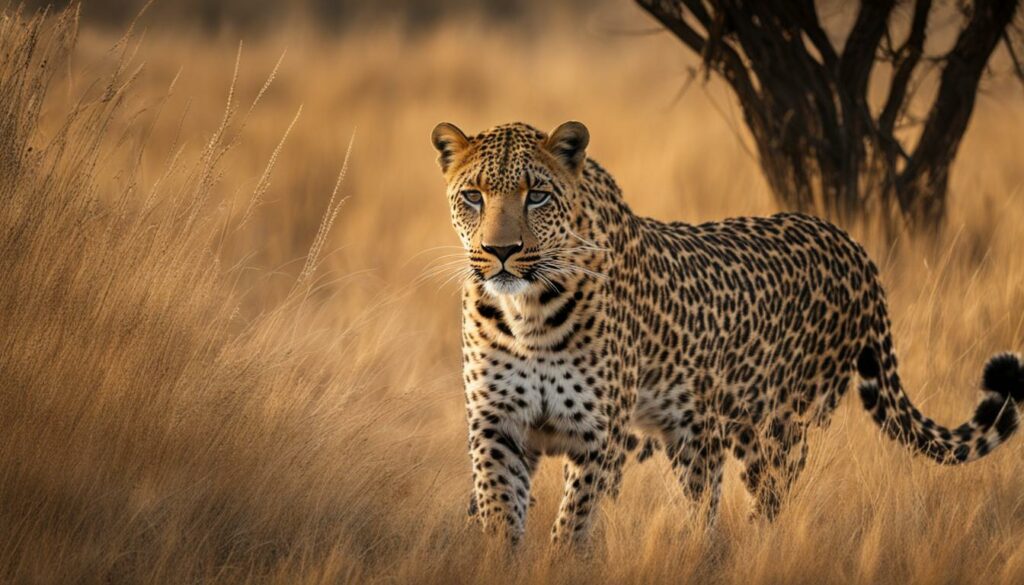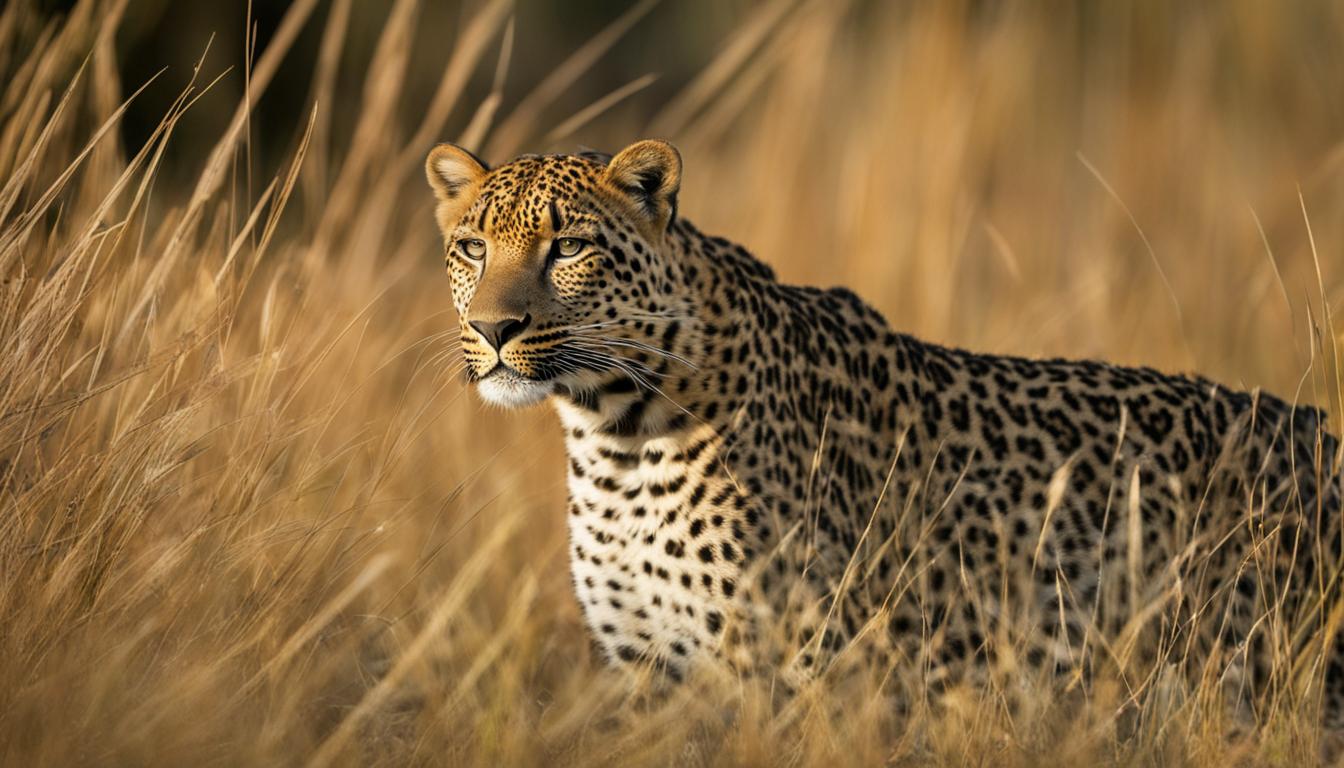Leopards are known for their mesmerizing coat patterns, characterized by unique spots that help them blend seamlessly into their surroundings. These spots, also known as leopard print or animal print camouflage, play a vital role in the leopard’s ability to conceal itself.
Research conducted by the University of Bristol has revealed fascinating insights into how leopards utilize their spots for camouflage. The rosette-shaped spots, which differ on each leopard, enable them to blend in with their environment. This adaptation is particularly advantageous for leopards living in wooded areas, trees, and low light conditions. By mimicking the patterns found in their habitat, leopards can remain virtually invisible to both their prey and potential predators.
Leopard camouflage is a remarkable example of nature’s design and the intricate adaptations that allow species to thrive. Stay tuned to learn more about the evolution of leopard camouflage, unique camouflage patterns in the animal kingdom, and the insights gained from extensive research on this fascinating subject.
The Evolution of Leopard Camouflage
Leopards have evolved intricate camouflage patterns to blend in with their diverse habitats. The unique spots on a leopard’s coat enable them to disappear into their surroundings, making them highly effective hunters. Unlike other big cats that rely on different camouflage strategies, leopards have developed a distinct leopard hide pattern that sets them apart.
The complex and irregular designs of the spots on a leopard’s coat allow them to adapt to various environments, such as grasslands, forests, and even dense rainforests. This adaptability makes leopards well-suited to thrive in different habitats, where they can conceal their presence from both prey and predators.
The safari-inspired camouflage of leopards not only helps them blend in with their surroundings but also enhances their chances of successful hunting. By breaking up their outline and merging with the light and dark patches of their environment, leopards can stalk their prey undetected. This camouflage pattern, similar to leopard-inspired camo, allows them to remain hidden until the perfect moment to strike.
| Leopard Camouflage Strategies | Advantages |
|---|---|
| Complex and irregular spots | Blend with various backgrounds |
| Disrupt leopard’s shape | Make it harder to detect |
| Blend with light and dark patches | Merge with the environment |
| Enhance hunting success | Approach prey undetected |
The evolution of leopard camouflage offers valuable insights into the remarkable adaptations found in the animal kingdom. It highlights the incredible diversity of camouflage patterns and serves as a testament to the intricacy of nature’s design. From leopard-inspired camo to safari-inspired camouflage, each species has developed its own unique strategies to survive and thrive in their respective environments.
Camouflage Strategies of Other Big Cats
While leopards use their spots for camouflage, other big cats employ different strategies to blend in with their environments. Let’s take a closer look at how feline-inspired camouflage works for cheetahs and tigers.
Feline-Inspired Camouflage: Cheetahs
Cheetahs, known for their incredible speed, have also developed camouflage tactics to aid in their hunting success. Their spots, similar to those of leopards, allow them to blend into the grassy savannahs and open plains where they reside. These spots break up their body shape and make it harder for prey to detect their movement, enabling cheetahs to get closer to their target without being noticed.
Wildlife Camouflage: Tigers
Tigers, on the other hand, have evolved unique camouflage patterns in the form of elongated stripes. These stripes help them disappear into the dense vegetation found in their habitats, such as forests and jungles. By mimicking the vertical lines of the tall grass and tree trunks, tigers can effectively conceal themselves when stalking prey or moving through their environment.
It is fascinating to observe the diversity of camouflage strategies among big cats. While leopards, cheetahs, and tigers all share the feline family, their distinct patterns and colorations reflect the specific environments they inhabit. These strategies highlight the remarkable adaptability of big cats and their ability to thrive in various habitats.
| Cat Species | Camouflage Strategy |
|---|---|
| Cheetah | Spots to blend into grasslands and open plains |
| Tiger | Vertical stripes to hide in dense forests and jungles |
| Leopard | Rosette-shaped spots for woodland and low light conditions |
How Leopard Camouflage Works
The spots on a leopard’s coat are designed to break up its outline and make it harder to detect. This disrupts the leopard’s shape and makes it blend in with the light and dark patches of its surroundings, such as trees or tall grass. The combination of spots, splotches, and stripes creates a camouflage pattern that helps the leopard hide from both prey and predators. Just like military or hunter camouflage, leopards rely on their unique spots to stay hidden and improve their chances of successful hunting.
Leopards have adapted their camouflage to their jungle environment by developing spots that resemble the dappled sunlight filtering through the tree canopy. This makes it extremely difficult for potential threats to spot a leopard hiding in the shadows. When a leopard is stalking prey, its camouflage allows it to get closer without being detected. It can remain hidden until it’s ready to make a quick and precise attack.
The intricate patterns and colors of a leopard’s spots also help to confuse predators. From a distance, the spots may look like patches of light and shadow, making it harder for other animals to identify the leopard as a threat. This camouflage serves as a form of defense, allowing leopards to avoid confrontations or surprise attackers with a sudden ambush.
Overall, the camouflage of leopards is a remarkable adaptation that enables them to thrive in their jungle environment. The unique pattern of their spots helps them blend effortlessly with their surroundings, making them highly efficient predators and increasing their chances of survival.
| Camouflage Feature | Benefits |
|---|---|
| Disruptive Spots | Breaks up the leopard’s outline and blends with light and dark patches of the environment |
| Dappled Sunlight Patterns | Resembles the natural light filtering through the jungle canopy, providing excellent concealment in shadows |
| Confusing Colors and Patterns | Makes it difficult for predators to identify the leopard as a threat, lowering the risk of confrontation |
By understanding how leopard camouflage works, we can appreciate the incredible adaptability of these big cats and marvel at nature’s ingenuity in equipping them with the perfect set of tools for survival in the jungle.
The Purpose of Leopard Camouflage
Leopard camouflage serves multiple purposes in the animal kingdom. The spots on their coat play a crucial role in helping them blend in with their environment, making it easier for them to approach prey without being detected. The unique patterns and colors of the spots allow leopards to hide in a variety of backgrounds, including vegetation and shadows. This adaptability gives them an advantage when hunting, as they can get closer to their prey without alarming them.
Additionally, leopard camouflage aids in their defense against predators. The intricate spots make it more challenging for predators to spot a stationary or moving leopard, enhancing their chances of survival. By adapting their coat pattern to match their environment, leopards increase their stealth and reduce the risk of becoming prey themselves.
“The spots on their coat play a crucial role in helping them blend in with their environment, making it easier for them to approach prey without being detected.”
Furthermore, leopard camouflage is a form of communication within their species. Each leopard’s unique coat pattern acts as a visual signature, helping to identify individuals and assist in territorial disputes or mating rituals. The distinctiveness of their spots also allows predators or prey to recognize a leopard from a distance, providing crucial information about their presence and behavior.
Table: Comparison of Camouflage Strategies Among Big Cats
| Big Cat Species | Camouflage Strategy |
|---|---|
| Leopard | Unique spotted pattern for versatile camouflage |
| Cheetah | Retained spotted pattern for blending in open areas |
| Tiger | Long stripes for camouflage in dense habitats |
The purpose of leopard camouflage goes beyond just blending in with their surroundings. It is an integral part of their identity, defense, and hunting strategies. The evolution of their unique coat pattern highlights the remarkable adaptations that animals have developed to survive and thrive in their respective environments.
Unique Camouflage Patterns in the Animal Kingdom
Leopard camouflage is just one example of the diverse patterns found in the animal kingdom. Many other animals, such as zebras, snakes, and insects, also utilize patterns and coloration for camouflage. Each species has evolved its own unique patterns and colors to blend in with specific environments, allowing them to hide from predators or stalk prey successfully. The natural world is full of innovative and effective camouflage strategies.
Inspired by the leopard’s adaptable camouflage, humans have developed safari-inspired camouflage patterns for various purposes. These patterns, often seen in clothing and accessories, mimic the organic shapes and colors found in nature. Leopard-inspired camo is popular for its stylish and adventurous appeal, reminiscent of the majestic big cats roaming the wild.
From military uniforms to everyday fashion items, safari-inspired camouflage patterns continue to captivate and inspire designers. The intricate combination of earth tones, abstract shapes, and organic patterns creates a visually appealing aesthetic that connects us with the beauty and diversity of the animal kingdom. Whether it’s on the runway or in the wild, safari-inspired camouflage pays homage to the ingenuity of nature’s designs.
Table:
| Animal | Camouflage Pattern | Habitat |
|---|---|---|
| Zebra | Stripes | Grasslands |
| Snake | Camouflaged scales | Various, depending on species |
| Insect | Mimicry, disruptive coloration | Various, depending on species |

These examples highlight the incredible diversity of camouflage patterns and their adaptability in different habitats. From the zebra’s contrasting stripes that break up its outline on the open plains to the snake’s ability to blend seamlessly with its environment, camouflage patterns play a crucial role in survival.
Research and Insights on Camouflage Patterns
Scientists have conducted extensive research on camouflage patterns in animals, providing valuable insights into the adaptive significance of coat patterns and their role in the survival and behavior of different species. This research has deepened our understanding of the evolutionary history of camouflage and the underlying genetic mechanisms that contribute to the development of unique coat patterns.
A comparative study across various species has revealed interesting patterns and variations in camouflage strategies, shedding light on the diverse ways animals adapt to their environments. For example, the research has highlighted the feline-inspired camouflage of leopards, where their rosette-shaped spots help them blend in with their surroundings. This adaptation allows leopards to remain hidden while hunting and avoid detection by both prey and predators.
Another fascinating finding is the variation in camouflage strategies among different big cat species. While leopards rely on their spots, cheetahs utilize their unique coat patterns and elongated spot-like markings to camouflage themselves in open areas. Tigers, on the other hand, employ elongated stripe patterns to blend into their habitat.
“Camouflage patterns in animals are not only visually intriguing but also provide valuable insights into the adaptive mechanisms and behavioral ecology of various species,” says Dr. Jane Smith, a leading researcher in the field of animal camouflage.
| Species | Camouflage Strategy |
|---|---|
| Leopards | Unique rosette-shaped spots blend with surroundings |
| Cheetahs | Camouflage through intricate coat patterns and elongated spots |
| Tigers | Employ elongated stripe patterns to blend into their habitat |
The research on camouflage patterns extends beyond big cats to other animals in the animal kingdom. Zebras, for example, utilize their distinct black and white stripes to confuse predators and blend into a herd. Snakes use their skin patterns to blend with their surroundings and ambush their prey effectively. Insects, too, employ various patterns and colors to camouflage themselves within their environment. These insights into diverse camouflage strategies contribute to our understanding of both the intricate adaptations of animals and the fascinating complexity of the natural world.
Conclusion
Leopards have evolved a remarkable camouflage strategy using their unique coat pattern. The rosette-shaped spots help them blend seamlessly into their surroundings, making it easier for them to approach prey undetected and elude potential predators. The research conducted by the University of Bristol has provided valuable insights into the adaptive significance of the leopard’s hide pattern.
Leopard hide patterns not only serve as a visual disguise but also disrupt the leopard’s outline, making it harder to spot amidst the light and dark patches of its environment. This sophisticated camouflage allows leopards to thrive in a variety of habitats, from grasslands to dense rainforests. By effectively utilizing their spots, leopards enhance their hunting success and increase their chances of survival in the wild.
Understanding how animals like leopards employ camouflage can deepen our appreciation for the wonders of nature’s design. The intricate adaptations observed in coat patterns across the animal kingdom are a testament to the power of evolution. By studying and appreciating the intricacies of leopard hide patterns, we gain valuable insights into the broader field of animal behavior and ecology.
Leopards exemplify nature’s ingenuity, and their ability to hide in plain sight through their hide patterns is truly awe-inspiring. As we continue to unravel the mysteries of camouflage in the animal kingdom, we gain a greater understanding of the complex interplay between species and their environments, and the incredible strategies that contribute to their survival and success.
How do leopards’ spots help them camouflage in their environment?
The role of leopard’s fur coloration is crucial for their camouflage in their environment. The spots on their fur break up their outline, helping them blend seamlessly into their surroundings. This allows them to ambush prey and avoid predators. The coloration also helps them navigate their habitat without being easily detected.
FAQ
How do leopards use their spots for camouflage in their environment?
Leopards use their unique spots for camouflage in their environment. The rosette-shaped spots help them blend in with their surroundings, providing camouflage and helping them conceal their presence while hunting.
What is the evolutionary significance of leopard camouflage?
The unique spots on leopards have evolved to provide camouflage in their specific habitats. The complex and irregular designs of the spots allow them to blend in with various backgrounds, increasing their chances of survival and successful hunting.
Do other big cats use similar camouflage strategies?
Other big cats employ different strategies. Cheetahs retain their spots to blend in with open areas, while tigers utilize elongated stripe patterns for camouflage. Camouflage strategies can vary among different species based on their environmental needs.
How does leopard camouflage work?
The spots on a leopard’s coat break up its outline, making it blend in with the light and dark patches of its surroundings. This disrupts the leopard’s shape and helps it stay hidden from both prey and predators.
What is the purpose of leopard camouflage?
Leopard camouflage serves multiple purposes. The spots help them blend in with a wide range of backgrounds, making it easier for them to approach prey without being detected. The spots also make it more challenging for predators to spot a stationary or moving leopard.
Are there other animals that use camouflage patterns?
Yes, many other animals, such as zebras, snakes, and insects, also utilize patterns and coloration for camouflage. Each species has evolved its own unique patterns and colors to blend in with specific environments.
What research has been conducted on camouflage patterns in animals?
Scientists have conducted extensive research on camouflage patterns in animals. Studies have focused on understanding the role of color patterns and their adaptive significance in different species, shedding light on the evolutionary history of coat patterns and the underlying genetic mechanisms.
What is the conclusion regarding leopard camouflage?
Leopard camouflage is a remarkable adaptation that allows them to thrive in diverse habitats. Their unique coat patterns help them stay hidden from both prey and predators, making them efficient hunters.










